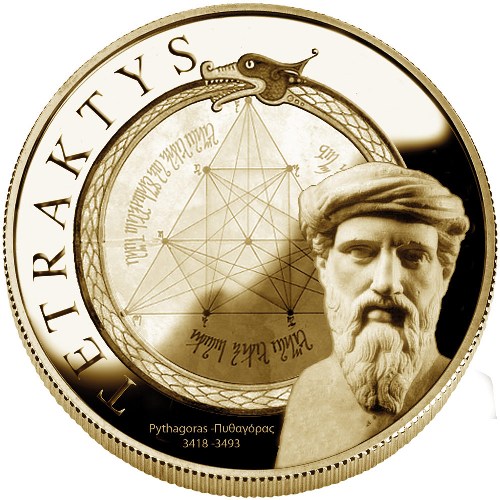Some of the most architectonically beautiful buildings that man ever designed were erected by our ancestors, the Operative Freemasons. They built them using unsophisticated technology and with rough working tools, yet even now we are filled with a great sense of admiration whenever we look at them! How did the Operatives accomplish it? They did it by applying a mathematical postulation to their building method that the Greek-born mathematician and philosopher Pythagoras[1] had rediscovered ; although the mathematical formula was known to both the Babylonians and the Egyptians well before his time. Pythagoras’s Theorem is of such importance that, centuries later, the Speculative Freemasons adopted its allegorical mystical significance and even showed it on one of the Craft’s jewel.
In Freemasonry, every passing Worshipful Master, at the end of his year in the Chair is invested with a collar from which hangs a jewel that symbolises the completion of his mandate and in a way of his “journey”. That regalia represent the highest honour that an Officer may receive from his Lodge, higher even to that of the presiding Master whose jewel – some Freemasons may say – instead of being a triangle is only a square without the hypotenuse! The ornament is a demonstration of Pythagoras’s theorem in terms of the 3 4 5 application method;it is a very significant symbol of the Craft and also the most emphatic tool of every Operative an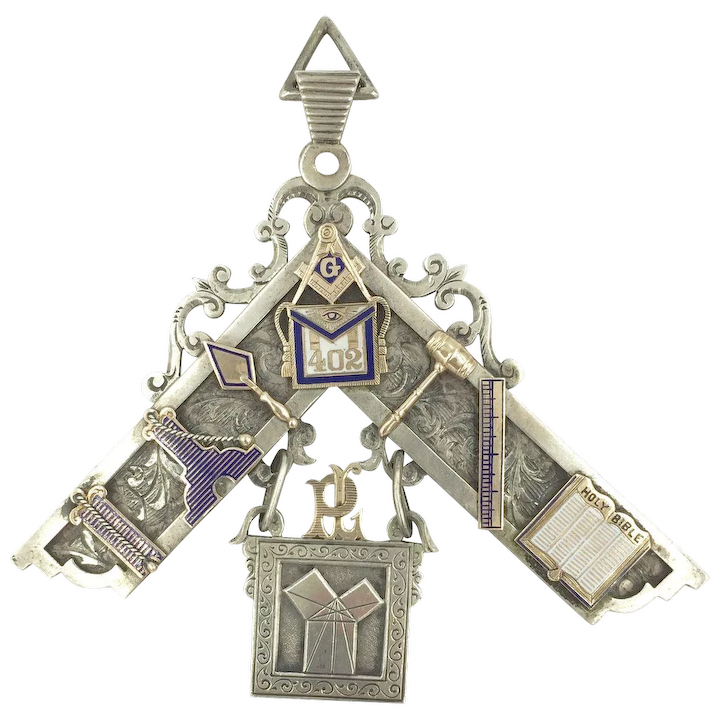 d Speculative Mason. Its importance lies further in the fact that the motif shown on the jewel is also a representation of the Square, the Level and Plumb Rule, which are tools used to prepare the ashlars[2]. It is a well known fact that unless the ashlars are
d Speculative Mason. Its importance lies further in the fact that the motif shown on the jewel is also a representation of the Square, the Level and Plumb Rule, which are tools used to prepare the ashlars[2]. It is a well known fact that unless the ashlars are 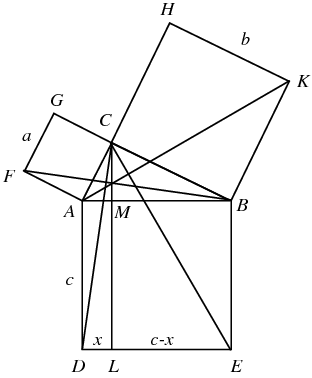 perfect the stability of a structure – be that physical or allegorical – is inevitably compromised. But many Past Masters do not know of the existence of Pythagoras’s theorem nor its meaning and just as I was, they are ignorant of the fact that it is represented on the regalia they wear in the Lodge.
perfect the stability of a structure – be that physical or allegorical – is inevitably compromised. But many Past Masters do not know of the existence of Pythagoras’s theorem nor its meaning and just as I was, they are ignorant of the fact that it is represented on the regalia they wear in the Lodge.
THE POSTULATION OF PYTHAGORAS’ THEOREM AND ITS PRACTICAL USE
The most important principles that are applied when erecting every new building are:
- the foundations must be perfectly upright
- the structure must be level
- its corners must have a perfect 90 degrees angles
These principles were valid and binding in ancient times as much as they are nowadays. Whether an Operative Freemason was paid to build a castle, a cathedral or a chateau, it was inconceivable of him to foul up the first step in the construction process because the alternative would have entailed his wages being withdrawn and his privileges being forfeited. One such privilege was that of the freedom to practice his trade wherever the Freemason chose to. A sort of lifelong Green Card and a right that the Freemason would have earned after seven years or more of apprenticeship in his respective craft.
Ensuring that a wall is level may be a relatively easy task to accomplish with the aid of the Plumb Rule – a piece of string at the end of which hangs a weight – but the process known even today as “squaring the room” is not that simple.

On the practical side we can assume that to minimise time and effort required to build the perfect 90 degrees corners of a structure, the Operatives Masons would have used an easy-to-assemble or perhaps even a pre-assembled wooden frame constructed by applying the theorem[3]. Pythagoras’ postulation – which later became better known as the Euclid’s 47th [4] proposition – states that : “In every right-angled triangle, the square of the Hypotenuse [5] , equals the sum of the squares of the other two shorter sides” which for the record are called Perpendicular and Base and are both shorter than the Hypotenuse. The triangle built with such criteria will be called a right triangle and have a 90 degrees angle which represents a perfect corner for any structure!
There are two ways to illustrate this; one is graphically and the other is with a mathematical formula.
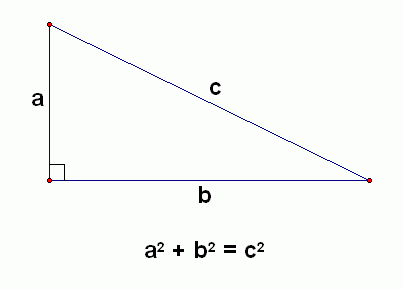
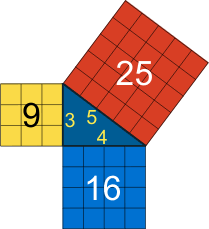
Let’s now take a look at how this works in practice. Say we have a triangle where the two short sides are 9 and 12. We don’t know what the long side is but we want to ensure that we obtain a right triangle. To find the long side, we can just plug the side lengths into the Pythagorean theorem. Thus 9 squared plus 12 squared equals C squared. That is to say: 81+144=225 and √225 = 15; so the Hypotenuse length must be 15 in order to return a triangle with a 90 degrees angle.
But there is a problem: the theorem only works for certain numbers. Those numbers are called Pythagorean Sequences Triplets and the smallest is 3 4 5; a sequence that makes the theorem both easy to comprehend and uncomplicated to put into practice.
Some of the other triplets are: 5 12 13, 6 8 10, 9 12 15, 8 15 17, 12 16 20, 15 20 25, and 7 24 25 and thousands more. They can be scaled up or down by multiplying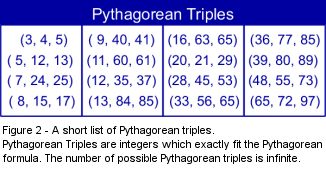
or dividing the length of each side of the triangle by the same number. For example, a 6-8-10 triangle is just a 3-4-5 triangle with all the sides multiplied by 2.
On the other hand, you cannot add or subtract the same number to all sides: there is no such thing as a 4-5-6 triangle!
To prove to you that only certain triplets will return a perfect 90 degrees angle in our chosen geometrical shape, let us look at what a triangle with a Base of 3 and a Perpendicular of 8 would return:
3 ×3 + 8×8 = 9+64 = 73
But 73 is a number that represents a huge practical problem because its square root does not return a whole number, or integer, but 8.5440037453 and so on to the infinitesimal. In other words the result of the Theorem is a number that was impossible to exactly measure with the tools then available to the Operatives.
A Pythagorean Triplet gives a triangle where all sides are integers and that explains why the triplet 3 4 5 is so popular.
In conclusion, the Operative Mason could have cut have cut a length of timber respectively into 3 4 and 5 units[6] – or scaled them up by using the criteria revealed earlier – laid them on the ground in the shape of a triangle and obtained a corner of 90 degrees onto which to lay the foundations of the building. Watch the video available at YouTube : https://www.youtube.com/watch?v=69cslx6ER7k to realise how our ancestors went about achieving a perfect 90 degrees corner.
There are of course many other ways of arriving at a right angle. One technique, which could have been used in antiquity, is that of drawing a circle on the ground and divide it in four exact parts, like in the picture below.
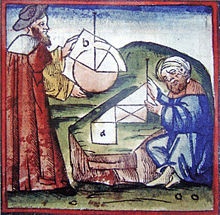
The triangle within each of those four parts will have a 90 degree angle. But such method would have required getting the alignment of the two axes absolutely right to north/south and west/east. This was achievable by looking at the night sky and the position of the stars but as a method it must have been time consuming and certainly less practical for checking the square angles of large buildings.
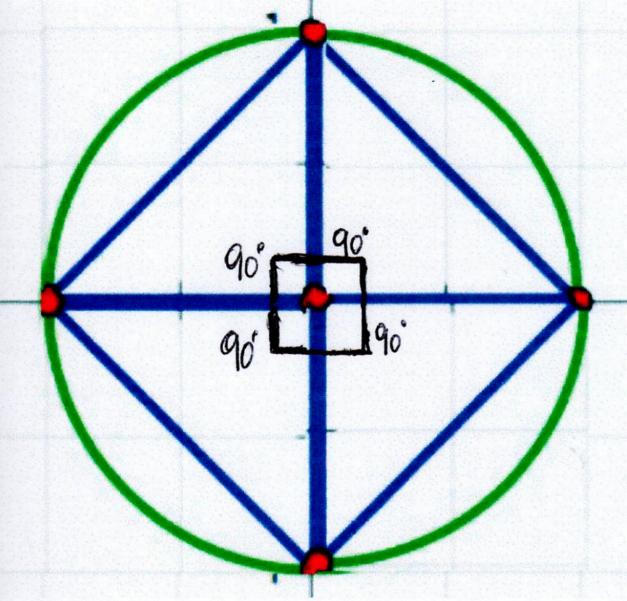
The circle, however, is just what is referred to in the second degree ritual of the Craft. When the Worshipful Master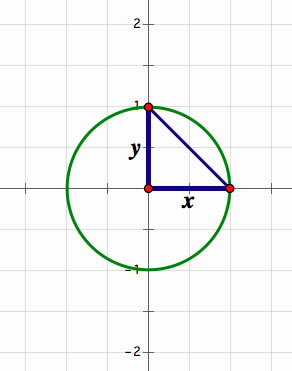 asks the Junior Warden the question “what is a square?” the Officer replies: “It is an angle of 90 degrees or the forth part of a circle”. A statement that would sound meaningless if you do not know a bit of Geometry and never heard of the Pythagoras’s Theorem!
asks the Junior Warden the question “what is a square?” the Officer replies: “It is an angle of 90 degrees or the forth part of a circle”. A statement that would sound meaningless if you do not know a bit of Geometry and never heard of the Pythagoras’s Theorem!
THE 3 4 5 TRIANGLE: AN ALLEGORICAL AND NUMEROLOGICAL INTERPRETATION.
Let me now quote you the reasons why the triangle constructed with a 90° angle has so much importance for the Craft as to be described “The Foundation of Freemasonry”.
The traditional esoteric doctrine claims that the sides of a right triangle represent
- God
- Man’s free will
- Destiny
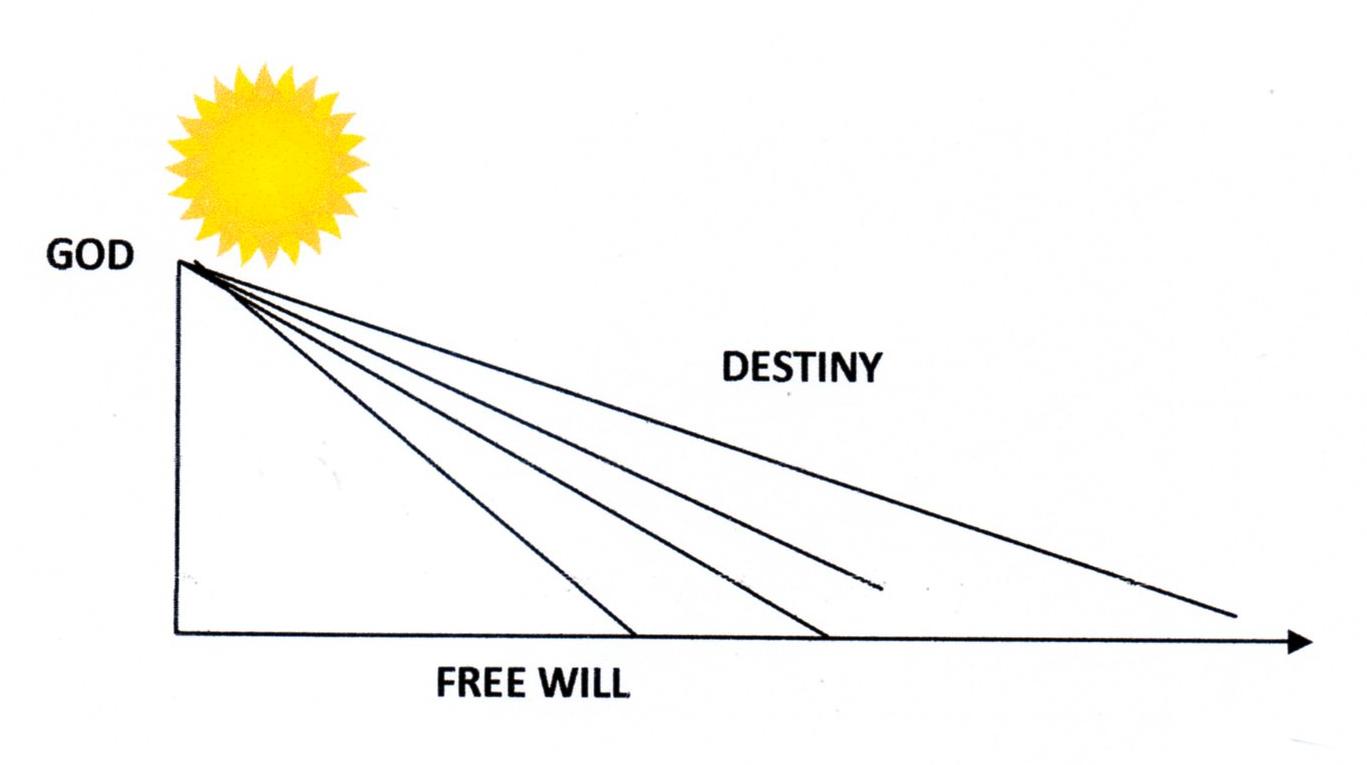 and suggests that balancing the relation between them allows man to advance in his spiritual journey. The longer man applies his “libero arbitrio” – or free will – the longer it will take him to join as one with God.
and suggests that balancing the relation between them allows man to advance in his spiritual journey. The longer man applies his “libero arbitrio” – or free will – the longer it will take him to join as one with God.
Numerology was a method employed by both the Pythagoreans and the Jews because it was believed that all numbers have mystical properties. Even in Freemasonry the presence of that science is noteworthy and important, although this aspect is rarely disclosed to the Brethren if at all.
For example, in Masonic Rituals the candidate is symbolically led to square the Lodge by being escorted around it 3 times during the EA Ritual, 4 times during a Fellow Craft Ritual and 5 times in a Master Mason Ritual. In the Fellow Craft degree, the explanation of the tracing board abounds with numbers : there is the “winding staircase” consisting of 3, 5 ,7 or more steps; the detailed description and dimensions of three pillars – Wisdom, Strength and Beauty – and chapters, the reference made to the five orders of Architecture [7] and to the seven Liberal Arts [8] . And it does not end there, though I have to stop myself from quoting them because the whole ritual book and every Masonic degree contain a multitude of sacred numbers.
A triangle is called rectangular because it contains an angle of 90 degrees. The number 90 is the product of 9 multiplied by 10, where 9 is a symbol of regeneration and Justice and the number 10 is the symbol of Perfection. The 90 degree angle can be interpreted as representing rectitude, a virtue that man needs to regenerate himself and return to the state of innocence that predated his original sin.
The Egyptians – whom earlier in the paper were referred to as people already in possession of the knowledge of Euclid’s 47th Proposition thousands of years before Pythagoras – identified the vertical line of the triangle measuring 3 units with their God Osiris . 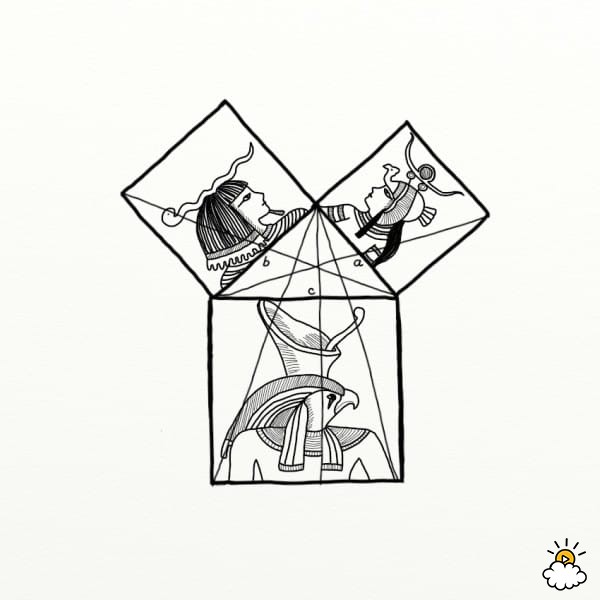 horizontal line of 4 units, was attributed to Isis and the Hypotenuse (5 units) to Horus, the son of Osiris and Isis [9]. Even the prominent American Freemason and author Albert Pyke, in his “Morals and Dogma” suggests that the triangle represents: the Spirit (Osiris), the Matter (Isis) and the union of the two (Horus). This is the same ancient principle of the Divine Trinity, where we have, according to Plutarch[10], the Perpendicular representing the Masculine, the Baseline representing the Feminine and the Hypotenuse of the sacred triangle representing the Offspring.
horizontal line of 4 units, was attributed to Isis and the Hypotenuse (5 units) to Horus, the son of Osiris and Isis [9]. Even the prominent American Freemason and author Albert Pyke, in his “Morals and Dogma” suggests that the triangle represents: the Spirit (Osiris), the Matter (Isis) and the union of the two (Horus). This is the same ancient principle of the Divine Trinity, where we have, according to Plutarch[10], the Perpendicular representing the Masculine, the Baseline representing the Feminine and the Hypotenuse of the sacred triangle representing the Offspring.
Even the units of the triangle’s side are significant!
The 3 units of the Osiris/vertical line have been attributed to the three Alchemical principles to which all things are a manifestation of, i.e.: Salt, Sulphur, and Mercury.
The 4 units of the horizontal line of Isis relate to the so-called four Elements that surround us: Earth, Air, Water and Fire. Finally, the ascending Horus line with its five units represents the five kingdoms: Mineral, Plant, Animal, Human and the 5th Kingdom identifiable with the Adept consciously reuniting with the Source of all things aka TGAOTU.
*******
In future I will endeavour to write about other similar secrets that it is claimed the Operative Freemasons kept close to their chest, but for now I would like to send a message of exhortation to all the Brethren and to the Candidates in particular to read deeper into the ritual book and the Volume of the Sacred Law. It will be worth your effort. Putting off or slowing down your Lodge Office progression until you will have assimilated the teaching of every degree will feel most rewarding.
To quote the philosopher Thomas Carlyle [11]: “In a symbol there is concealment and yet revelation”. So mote it be.
THE ANECDOTE
After the creation of the Grand Lodge of England the Old Charges of the London Company of Masons, dating back to the 14th century, were replaced with the “Constitutions”, written by the Rev. Dr James Anderson and printed in January 1723, with a second edition released in 1738.
The Frontispiece of the original volume of those “Constitutions” depicts a classical arcade with two individuals in its foreground. 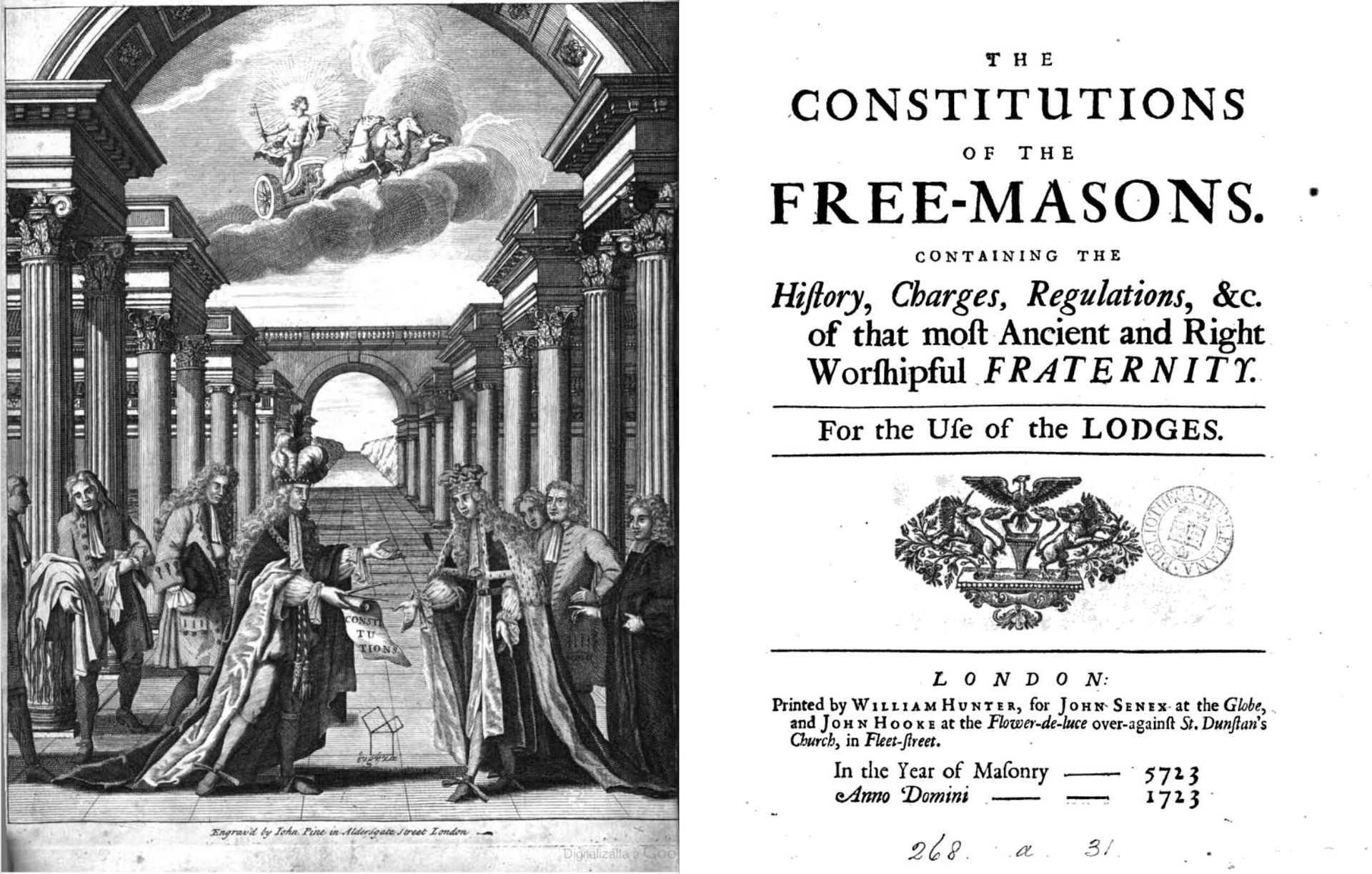
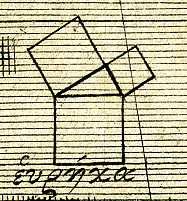 The one on the left is possibly the Grand Master the Duke of Montagu and he can be seen passing the scroll of the Constitutions to the other Grand Master, Philip, Duke of Wharton. Both Grand Masters have attendants and the one in the left is shown carrying an apron and a pair of gloves. In between the principal figures, is a diagram of Pythagoras’s Theorem with the Greek word “Eureka” – which in Ancient Greek means “I have found it” – written beneath it.
The one on the left is possibly the Grand Master the Duke of Montagu and he can be seen passing the scroll of the Constitutions to the other Grand Master, Philip, Duke of Wharton. Both Grand Masters have attendants and the one in the left is shown carrying an apron and a pair of gloves. In between the principal figures, is a diagram of Pythagoras’s Theorem with the Greek word “Eureka” – which in Ancient Greek means “I have found it” – written beneath it.
Anderson must have thought that it was Pythagoras who exclaimed “Eureka!” when in truth the expression belongs to Archimedes [12] , an inventor and mathematician from Syracuse, Sicily who lived centuries after Pythagoras. The story goes that one day, on a visit to Syracuse’s public baths, Archimedes realized that the more his body sunk into the water the more water it displaced, making the expelled liquid an exact measure of his body volume. This sudden discovery of the relation between density and volume [11] made the naked Archimedes run out of the baths and onto the city streets shouting “Eureka! Eureka!”
Anderson believed Euclid’s 47th proposition to be the “Foundation of all Masonry, sacred, civil and military!” and yes, confusing Pythagoras with Archimedes is an unforgivable inaccuracy but it takes little away from the work that our esteemed Grand Warden Rev. Brother James Anderson did for the Craft!
By W.Bro Leonardo Monno Anglisani
The author forbids any reproduction or publication of this article, in full or in part, without his explicit authorization.
[1] Born c.570BC, Samos, Greece, Pythagoras settled in Crotone, Calabria , Italy and died c. 490-500 BC at Metapontum, Lucania, Italy
[2] The Ashlar is a cubic stone
[3] Pythagoras proved the theorem, Euclid published it in his Book One, two centuries later.
[4] Because it was the 47th problem out of 465 that Euclid proved in his book.
[5] Hypotenuse: the name with which the longest side of a triangle is known
[6] Where the units could have been any of those in usage at the time , like for example : cubits , palms, feet or thumbs.
[7] The Tuscan, Doric, Ionic, Corinthian, Composite
[8] Grammar, Rhetoric, Logic, Arithmetic, Geometry , Music and Architecture
[9] It is bizarre that in the myth of Osiris and Isis, Osiris is killed thus making Horus : the Son of a Widow and links him to Hiram !
[10] Plutarch of Chaeronea in Boeotia (ca. 45–120 CE) was a Platonist philosopher. He wrote extensively about ancient Greek and Roman culture
[11] A philosopher and poet , was born 4 December 1795 at Ecclefechan a small village in the south of Scotland in Dumfries and Galloway, died 5 February 1881 in London
[12] Born 288BC in Syracuse, Sicily, Italy and died 212/211BC in Syracuse.
[13] A body immersed in fluid loses weight equal to the weight of the amount of fluid it displaces.
Sources: “Euclid on the square” by Craig Gavin – The Square magazine, Vol. 30,Mmarch 2004 “The 47th Problem of Euclid” by H.Maij, August 2009 https://study.com/academy/lesson/properties-of-3-4-5-triangles-definition-and-uses.html “Trigonometry Concepts” by Albano Martín De La Scala “The 47th problem of Euclid – the veil lifted” - By Bro. Wm Steve Burkle – Scioto Lodge 6, Chillichote, Ohio, published in Pietre &Stones “Geometry and Masonry” By W.Bro. Harvey Lovell (Lodge Millaa Millaa 351 – UGL of Queensland, AU, Pietre &Stones
- MUSIC AND THE CRAFT – LUIGI BORGHI , A FREEMASON OF THE NINE MUSES LODGE - October 31, 2022
- SPILSBURY – THE FREEMASON FATHER OF FORENSIC SCIENCE - April 18, 2022
- THE MASONIC GLOVES - March 21, 2022

